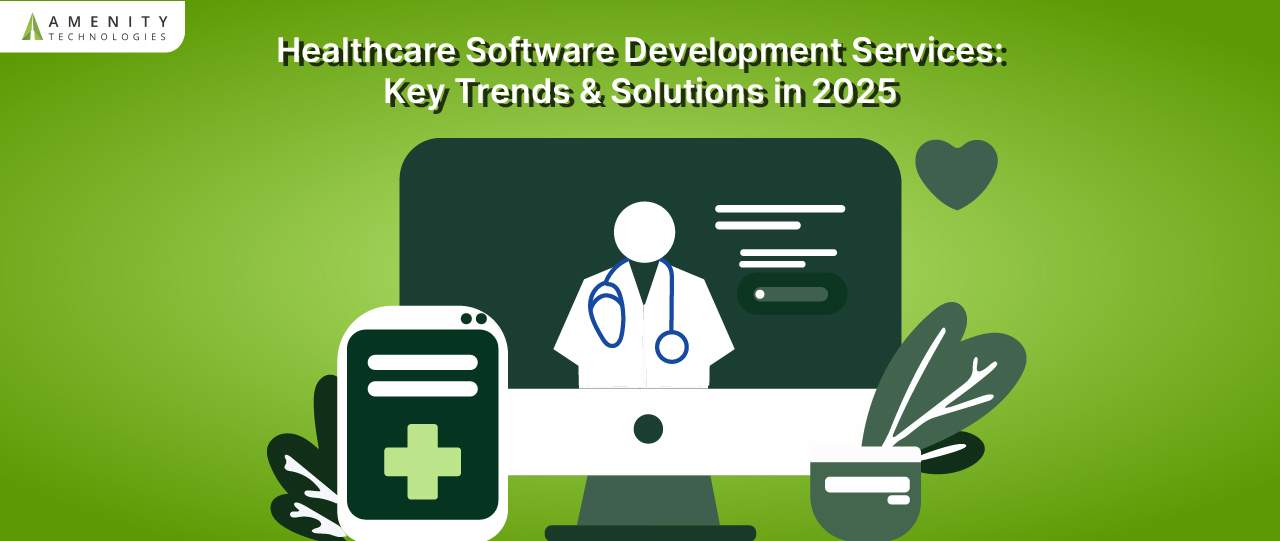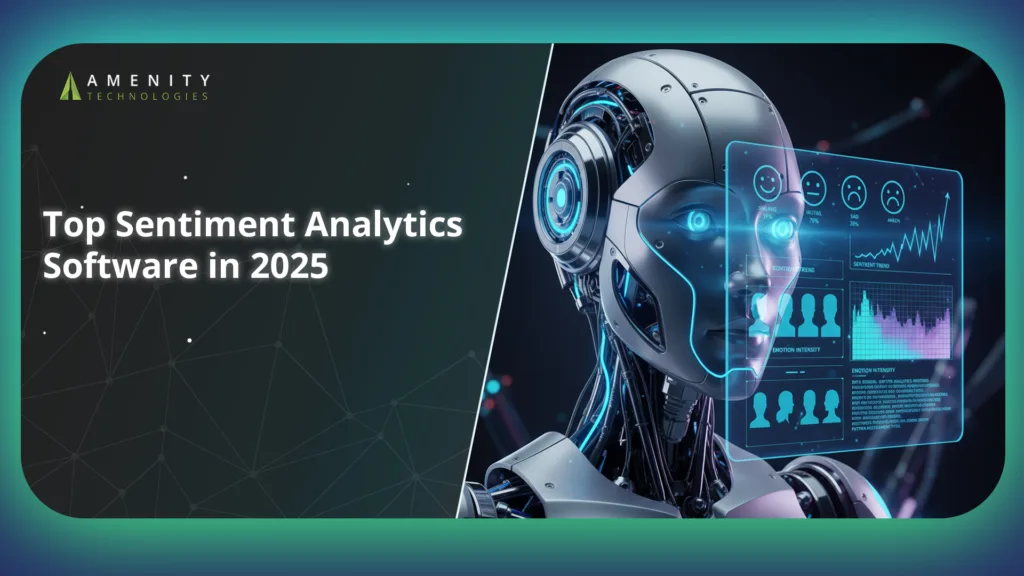Healthcare IT in 2025 demands more than basic record systems. Healthcare software development services now influence how doctors treat patients, how administrators manage workflows, and how secure data moves between systems.
Can your hospital rely on outdated tools when custom EMR platforms and medtech software solutions offer faster, safer results? Why settle for partial integrations when clinical dashboards and patient monitoring apps are available to improve care coordination?
From HIPAA-compliant development to secure healthcare data apps and AI-enabled diagnostics, providers expect full-scale support. This blog outlines trends, EMR migration priorities, and how to pick the right development partner.
What Defines Modern Healthcare Software Development Services?
Modern healthcare software development services define how hospitals, clinics, and digital health startups deliver care in 2025. Leaders no longer look at software as a side tool. They want platforms that fit clinical processes, safeguard patient data, and scale across geographies. The following dimensions shape what healthcare organizations now expect.
1. Built for Clinical Workflows: EMR, EHR, Diagnostic Integration, Clinical Dashboards
Clinical workflows demand accuracy and speed. Development teams must design custom EMR platforms that match how clinicians record and access patient data. Integration with diagnostic devices allows lab results and imaging to flow directly into patient records without manual uploads.
Effective clinical dashboards display only the most relevant information for each role, reducing clicks for physicians and surfacing operational metrics for administrators. By aligning systems with real-world tasks, software minimizes clinician fatigue and improves care delivery.
2. Security & Regulatory-First: HIPAA, GDPR, Patient Data Encryption, Audit-Ready Architecture
Security is non-negotiable in healthcare. HIPAA-compliant development means more than checking boxes, it requires encryption at rest and in transit, strict access controls, and logged activity trails.
With GDPR and regional privacy laws shaping global compliance, vendors must offer configurable policies for international clients. Audit-ready architecture ensures health organizations can provide detailed logs during inspections without scrambling for evidence.
Recent high-profile data breaches underline why organizations heavily invest in monitoring and automated alerts to protect sensitive medical records.
3. Scalable, Integrated Tools: Patient Monitoring, Telehealth, Care Coordination, Mobile-First Apps
Health systems often start small but need room to grow. Solutions that support patient monitoring apps, telehealth visits, and care coordination tools allow providers to scale without re-platforming.
Mobile-first designs keep clinicians connected with patient updates, even outside traditional workstations. Scalability also means handling spikes in virtual visits, syncing with wearable devices, and maintaining uptime under load.
The right medtech software solutions give healthcare teams a unified set of applications that adapt as service models expand across new departments or geographies.
4. Interoperable Platforms: Seamless Data Exchange, FHIR Standards, Legacy System Migration
Disconnected systems waste staff time and frustrate patients. That is why modern healthcare software development services must prioritize interoperability.
FHIR standards and open APIs create the backbone for data exchange between providers, insurers, and third-party apps. For organizations tied to outdated EMRs, robust migration frameworks are essential to move legacy data without downtime or record loss.
When interoperability works, care teams share records instantly, patients avoid duplicate tests, and administrators gain reliable datasets for analytics. Interoperability is no longer a feature, it is a requirement.
5. UX-Centric Design: Interfaces for Clinicians, Patients, Administrators
The quality of user experience directly affects adoption. Clinicians reject clunky platforms that slow down documentation or require excessive clicks.
Patients expect simple portals that let them check records, pay bills, or message care teams without confusion. Administrators need dashboards that present billing, scheduling, and compliance data clearly. Healthcare software development services that focus on UX testing with all three groups prevent costly redesigns later.
Modern medtech software solutions prioritize accessibility standards and device compatibility, ensuring every user interacts with the platform smoothly, whether on desktop or mobile.
Key Healthcare Software Trends in 2025
The priorities for healthcare IT are shifting fast. Providers now expect healthcare software development services to integrate with clinical care, improve interoperability, and protect sensitive data. These are the trends shaping development in 2025.
1. Telehealth and Remote Monitoring Expansion
Telehealth has become a standard delivery model, not an optional add-on. Patients expect video consultations, prescription management, and access to care from anywhere.
Patient monitoring apps extend this model by capturing vital signs through wearables and home devices, feeding real-time updates into custom EMR platforms. This shift improves chronic disease management and reduces hospital readmissions.
For development partners, the challenge is building scalable infrastructure that handles spikes in demand while complying with HIPAA. Healthcare software development services that fail to offer robust telehealth features will quickly lose relevance.
2. AI-Driven Diagnostics and Personalized Medicine
Artificial intelligence is no longer experimental. AI models now support diagnostic imaging, pathology, and clinical decision support.
Predictive analytics help clinicians design personalized treatment plans, improving outcomes for conditions like cancer and diabetes. Medtech software solutions that embed AI features must include explainability and audit trails so clinicians can trust the outputs.
In 2025, healthcare software development services are expected to integrate AI-driven alerts directly into clinical dashboards, reducing delays and supporting more precise care delivery. Without this, hospitals risk falling behind competitors already adopting AI.
3. Interoperability Breakthrough via FHIR and API
Fragmented systems waste both clinician time and patient patience. FHIR standards now dominate interoperability strategies. APIs built on FHIR connect legacy EMRs, insurance platforms, and new digital health apps without manual data entry.
Vendors offering HIPAA-compliant development must also validate that APIs meet security standards, preventing unauthorized access. Healthcare software development services in 2025 are judged by how well they migrate outdated records into modern systems while ensuring compliance.
The result is faster care coordination and better insights from unified patient data.
4. Digital Therapeutics and AR/VR for Accessibility
Digital therapeutics are moving into mainstream healthcare. FDA-cleared apps now support behavioral health, chronic pain, and neurological rehab.
At the same time, AR and VR tools make therapy more engaging and accessible for patients who struggle with traditional interventions. For developers, the focus is on seamless integration with secure healthcare data apps so providers can track outcomes and report progress.
Healthcare software development services that add AR/VR modules into existing platforms improve patient engagement and provide new revenue streams for clinics.
5. Cybersecurity and Data Privacy as Core
Ransomware attacks and data breaches continue to hit hospitals. Providers expect healthcare software development services to embed cybersecurity controls at every layer.
This means strong encryption, penetration testing, and compliance with both HIPAA and GDPR. HIPAA-compliant development is no longer a selling point, it is assumed. What sets top vendors apart is real-time monitoring, incident response readiness, and integration with secure infrastructure providers.
By protecting patient records and keeping uptime consistent, developers build trust with both clinicians and patients.
Why Amenity Technologies Provides the Best Healthcare Software Development Services in 2025?
Choosing the right vendor for healthcare software development services can decide how effective, secure, and scalable a health system becomes. Amenity Technologies stands out by focusing on clinical accuracy, compliance, and modern delivery methods that meet global standards. Here’s how our approach delivers measurable outcomes.
1. Clinical-Centric Engineering: Building from Patient Workflows to Diagnostic Support
We begin with real clinical processes, not abstract features. Our teams map patient journeys and physician tasks directly into system requirements. This ensures custom EMR platforms and clinical dashboards align with how clinicians actually work.
Diagnostic device integration is tested with real hospital setups, allowing results to appear instantly in patient records. The outcome is reduced manual entry and faster decision-making at the point of care.
2. Compliance-First Architecture: HIPAA, GDPR, FHIR-Ready, EMR Integration
We treat compliance as a design principle, not a final checklist. Our HIPAA-compliant development framework includes data encryption, role-based access, and automated audit logs. For global providers, GDPR and regional rules are built into workflows.
By offering FHIR-ready APIs and EMR migration strategies, we reduces the risks that come with upgrading legacy systems. This proactive approach saves organizations from expensive remediation later.
3. AI-Enabled Solutions: From Telehealth to Predictive Diagnostics and Custom Dashboards
Artificial intelligence is built into our software solutions with governance in mind. Our AI features support predictive diagnostics, automated triage, and population health analytics, all integrated directly into clinical dashboards.
Every AI model includes validation protocols, explainability tools, and continuous monitoring so clinicians can rely on results. For telehealth, AI-driven features like automated scheduling and patient symptom checkers reduce administrative load while improving access.
4. Scalable Toolkits: Portable, User-Centric Apps that Launch Fast and Grow Seamlessly
We have designed systems that grow with organizations. From patient monitoring apps to telehealth portals, each tool is built on modular microservices that allow easy expansion.
Continuous delivery pipelines mean new features reach providers quickly without downtime. Mobile-first design ensures physicians, patients, and administrators get reliable access regardless of device.
5. Regional-Ready Delivery: Trust, Collaboration, and Experience Across US, AUS, EU, and Middle East
Healthcare regulations vary widely, and Amenity has proven experience adapting to each market. We provide region-specific compliance templates, ensuring projects align with US HIPAA standards, Australia’s My Health Record framework, EU GDPR requirements, and Middle East privacy laws.
Conclusion
Modern healthcare software development services must combine innovation with strict security and practical usability. Providers in 2025 expect more than custom EMR platforms: they want telehealth support, patient monitoring apps, AI-driven diagnostics, and reliable interoperability.
The right partner proves value through compliance-first design, clinical alignment, and scalable delivery. Amenity Technologies delivers on these expectations with proven expertise across regions and regulations. For healthcare organizations, precision in software design translates directly to safer care and stronger patient outcomes.
FAQs
1. What makes healthcare software development different from general software?
Healthcare software development services handle sensitive patient records and operate under strict compliance laws. Unlike standard software, these systems must follow HIPAA-compliant development, protect data with encryption, and align with medical workflows. They also need clinical validation so doctors trust results, whether it’s from custom EMR platforms or diagnostic tools.
2. How big is the shift toward telehealth and remote monitoring?
The shift is significant. Telehealth is now a standard expectation across providers, not an optional service. Patients want video consultations, e-prescriptions, and integrated billing. At the same time, patient monitoring apps connected to wearables let providers track chronic conditions outside clinics. With market growth accelerating, healthcare software development services must ensure these tools run reliably at scale while protecting patient privacy.
3. What role does AI play in healthcare software services?
AI supports diagnostics, administrative tasks, and patient engagement. In practice, it powers predictive analytics for treatment planning, automated triage, and population health management. When built into clinical dashboards, AI tools help physicians make faster decisions. Medtech software solutions that include explainability and monitoring ensure AI outputs are safe, reliable, and actionable.
4. Why is interoperability via FHIR so important?
Interoperability allows providers to exchange records seamlessly across systems. Using FHIR APIs, healthcare software development services connect legacy EMRs, insurance systems, and new apps without delays. This improves care coordination, reduces duplicate tests, and gives administrators reliable datasets. Without interoperability, organizations face silos that limit efficiency and patient satisfaction.
5. How essential are AR/VR and digital therapeutics in 2025?
Adoption is growing quickly. FDA-cleared digital therapeutics support behavioral health and chronic pain management. AR and VR help patients with rehabilitation and therapy by creating immersive sessions. For providers, integration into secure healthcare data apps means progress can be tracked and outcomes measured. Healthcare software development services that support these tools give clinics new treatment options and stronger patient engagement.
6. What should small health providers expect from post-launch support?
Support should not stop at deployment. Providers need ongoing security updates, compliance audits, uptime monitoring, and new feature rollouts. Post-launch services should also cover EMR migration adjustments, integration with medical devices, and responsive troubleshooting. Vendors offering healthcare software development services must commit to continuity so smaller practices stay compliant and competitive without technical disruptions.












